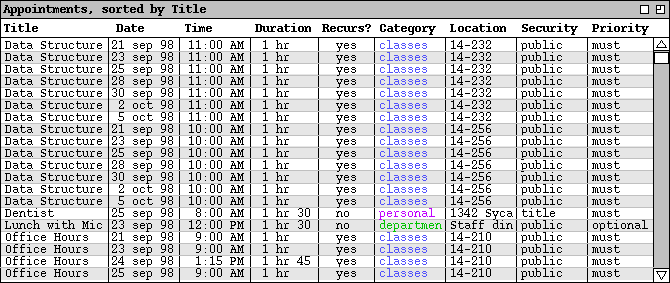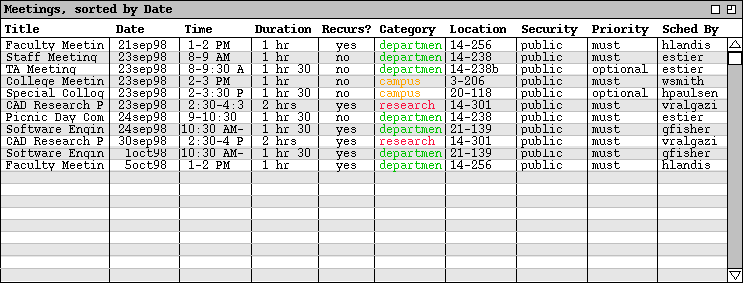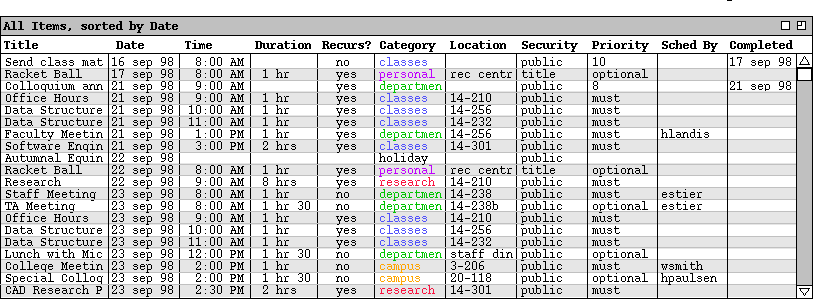
The calendar views described in
Section 2.3.1
are organized in standard calendar units of days through years. The user may
also view scheduled items in the alternate form of ordered lists. To view a
list of scheduled items, the user chooses the `View Lists' menu
command. In response, the system displays the submenu shown in Figure 26.

Figure 26: View lists submenu.
The first four commands are used to list the four different types of scheduled item. The fifth `All Items' command displays a list of all four types of scheduled item. The last command displays a menu of custom views created by the user.
[EDITORIAL NOTE: We need to update the top-level menu picture in the ui- overview section to reflect the newer version of the view lists submenu shown in the figure above.]
By default, one separate window is used for each of the six subcommands. For example, if the user executes `View Lists Appointments' followed by `View Lists Meetings', both an appointments list and meetings list window are displayed on the screen. Hence, there are up to six list windows, each holding the result of the most recently executed listing command. When the user re-executes a particular `View Lists' command, that command's display is changed (if necessary) and brought to the front, without a new window being created. For example, if the user executes `View Lists Appointments', then adds two new appointments, and re-executes `View Lists Appointments', the appointments-list display window is changed, with no new window created.
As for the view-level commands of Section 2.3.1, the user may change the default display style by enabling two-window or multi-window viewing mode. In two-window mode, the results of view commands are shown in just two windows, one for calendars and the other for lists. In multi-window mode, the results of each and every viewing command are shown in a separate new window, even for lists of the same type. For example, if the user executes two successive `View Lists Meetings' commands in multi-window mode, the results are shown in two separate meeting list windows. Complete details of multi-window viewing are described in Section 2.3.6.
Multi-window lists are particularly useful when applied in conjunction with
filtered viewing. For example, the user can display a list of two different
categories of appointments in two separate side-by-side windows. Complete
details of filtered viewing are presented in
Section 2.3.4.
2.3.3.1. Appointment Lists
Figure 27 shows the response to the user's selection of the `View Lists
Appointments' command.

Figure 27: Basic Appointments List.
The figure shows a list of appointments created by the user in the scenarios presented thus far. By default, the list is sorted primarily by date, secondarily by time, thirdly by duration, and fourthly by title. The default date range of the list is the three-week period starting one week prior to today's date. The default physical height of the list display window is twenty items. Any of these default settings can be changed using the options commands described in Section 2.8.2.2.
For the ongoing scenario, the current date is September 23. This means that the three-week period covers the dates September 16 through October 6, inclusive. Since there are more than twenty appointments scheduled in this period, the list window can be scrolled or resized to view the additional items.
The items in an appointments list are a somewhat abbreviated version of the information for a scheduled appointment. The precise extent of the abbreviations is as follows:
The user can change the default order of the list by clicking on any of the
column labels that appear in the display. For example, if the user clicks on
the Title column label in
Figure 27
the system updates the display to that shown in Figure 28, where the list items
are sorted alphabetically by title.

Figure 28: Appointments list sorted by title.
Since no single field value in an appointment is necessarily unique, the
primary sorting order must be augmented with secondary, tertiary, quaternary
and in some cases quintinary orders. Table 1 specifies the precise subordering
for each of the column labels used as the primary sorting key.
| Primary | Secondary | Tertiary | Quaternary | Quintinary |
| Title | Date | Time | Duration | |
| Date | Time | Duration | Title | |
| Time | Date | Duration | Title | |
| Duration | Date | Time | Title | |
| Recurs | Date | Time | Duration | Title |
| Category | Date | Time | Duration | Title |
| Location | Date | Time | Duration | Title |
| Security | Date | Time | Duration | Title |
| Priority | Date | Time | Duration | Title |
Table 1: Sorting suborders for appointment and meeting lists.
Figure 28 shows how the banner of a list window is altered to indicate that a sorting order other than the default is in use. The format of the banner for all list displays is the following:
type-of-list, sorted by field-namewhere type-of-list is one of Appointments, Meetings, Tasks, Events, or All Items; field-name is the name of item field used as the primary sorting key.
The default date range of the list can be changed using the custom list
features described in
Section 2.3.3.6,
as well as with the filtering commands described in
Section
The default display height and width can be changed using the general option
commands described in
Section 2.8.2.2.
2.3.3.2. Meeting Lists
To view a list of scheduled meetings, the user selects the `View Lists
Meetings' menu command. Figure 29 shows the result of the user so doing.

Figure 29: Meetings List.
The default sorting order for meeting lists is the same as for appointments.
The `Sched By' column is sorted lexically in the same manner as
`Title'. When `Sched By' is used as the primary sorting key,
the secondary through quintinary sorting keys are, respectively: Date, Time,
Duration, and Title.
2.3.3.3. Task Lists
When the user selects the `Tasks' command from the `View
Lists' menu, the system displays a window of the form shown in Figure 30.

Figure 30: Tasks list.
By default, the task list is sorted primarily by due date, secondarily by due time, thirdly by title. Tasks without a user-specified due time are considered to have a time after those with user-specified due times.
As for the appointments list, the task list is an abbreviation of the full information for scheduled tasks. Specifically,
Also as with appointments lists, the user can change the default order of the list by clicking on any of the column labels that appear in the display. For list columns that are common to both appointments and tasks, the precise sorting rules for tasks lists are the same as those given above for appointment lists. Sorting rules for the other task list columns are as follows:
| Primary | Secondary | Tertiary | Quaternary |
| Title | Date | Time | |
| Due Date | Time | Title | |
| Due Time | Date | Title | |
| Recurs | Date | Time | Title |
| Category | Date | Time | Title |
| Security | Date | Time | Title |
| Priority | Date | Time | Title |
| Completed | Date | Time | Title |
Table 2: Sorting suborders for task lists.
These are the same subordering rules as for appointments, without the
Duration field.
2.3.3.4. Event Lists
Figure 31 shows the result of the user selecting the `View Lists
Events' command.

Figure 31: Events list.
Events do not recur, but multi-day events can be defined with a start and end date. There is a separate list item for each day of a multi-day event. For example, there are three separate list items for an event with start date September 21 and end date September 23.
The events-list columns are a subset of the appointments list. For those columns that are present in the events list, the precise sorting rules are the same as given above for appointment lists.
The subordering for each of the primary sorting keys is given in Table 3.
| Primary | Secondary | Tertiary |
| Title | Date | |
| Date | Title | |
| Category | Date | Title |
| Security | Date | Title |
Table 3: Sorting suborders for event lists.
The final listing form contains all four types of scheduled item together in
one list. To select this form, the user executes the `View Lists All
Items' command, in response to which the system displays a window of the
form shown in Figure 32.

Figure 32: All items list.
By default, the list is sorted primarily by date. Among items of the same type, the precise sorting rules for each list column are as stated above in Sections 2.3.3.1, 2.3.3.2, 2.3.3.3, and 2.3.3.4 above.
Table 4 gives the subordering for all possible primary keys, of which there are
twelve in the all-items list.
| Primary | Secondary | Tertiary | Quaternary | Quintinary |
| Title | Date | Time | Duration | |
| Date | Time | Duration | Title | |
| Time | Date | Duration | Title | |
| Due Time | Date | Time | Duration | Title |
| Duration | Date | Time | Title | |
| Recurs | Date | Time | Duration | Title |
| Category | Date | Time | Duration | Title |
| Location | Date | Time | Duration | Title |
| Security | Date | Time | Duration | Title |
| Priority | Date | Time | Duration | Title |
| Sched By | Date | Time | Duration | Title |
| Completed | Date | Time | Duration | Title |
Table 4: Sorting suborders for all-item lists.
The `Time' field applies to appointments and meetings, representing the start time of the item. `Due Time' applies only to tasks, representing the time the task is due. The `Time' and `Due Time' columns are distinct in the all-items list so that the relative order among appointments, meetings, and tasks can be made consistent with the order among these items in calendar views.
The following assumptions are made for sorting lists with different types of items, in which one or more of the suborder keys are missing:
The custom lists feature of the Calendar Tool allows the user to define specialized forms of lists. In particular, the user can specify which types of items appear in a list, which item fields appear as list columns, and what range of dates the list covers. For example, the user can define a list that shows only the title and date of appointments and meetings for the next six months.
Details upcoming. Note that we need to update the View Lists submenu to
include a custom lists item.